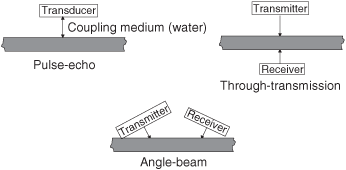Ultrasonic inspection — Ultrasonic inspection. См. Ультразвуковой контроль. (Источник: «Металлы и сплавы. Справочник.» Под редакцией Ю.П. Солнцева; НПО Профессионал , НПО Мир и семья ; Санкт Петербург, 2003 г.) … Словарь металлургических терминов
ultrasonic inspection — a means of locating defects in steel. When acoustic energy in the ultrasonic range is passed through steel, the sound waves tend to travel in straight lines, rather than diffusing in all directions as they do in the audible range. If there is a… … Mechanics glossary
resonance method of ultrasonic inspection — A method of detecting material thickness or an indicator of the internal damage by injecting variable frequency ultrasonic energy into a material. A specific frequency of energy will produce the greatest return in a given thickness of material.… … Aviation dictionary
inspection — dye penetrant inspection ultrasonic inspection … Mechanics glossary
Ultrasonic welding — is an industrial whereby high frequency ultrasonic acoustic vibrations are locally applied to workpieces being held together under pressure to create a solid state weld. It is commonly used for plastics, and especially for joining dissimilar… … Wikipedia
Ultrasonic testing — Step 1 : The UT probe is placed on the root of the blades to be inspected with the help of a special borescope tool (video probe). Step 2 : Instrument settings are input. Step 3 : The probe is scanned over the blade root. In this case, an… … Wikipedia
Inspection — Maintenance check of electronic equipment on a U.S. Navy aircraft. An inspection is, most generally, an organized examination or formal evaluation exercise. In engineering activities inspection involves the measurements, tests, and gauges applied … Wikipedia
Rail inspection — is the practice of examining rail tracks for flaws that could lead to catastrophic failures. According to the United States Federal Railroad Administration Office of Safety Analysis, [ [http://safetydata.fra.dot.gov/officeofsafety/ Federal… … Wikipedia
Thermographic inspection — refers to the nondestructive testing of parts, materials or systems through the imaging of the thermal patterns at the object s surface. Strictly speaking, the term thermography alone, refers to all thermographic inspection techniques regardless… … Wikipedia
Internal rotary inspection system — (IRIS) is an ultrasonic method for the nondestructive testing of pipes and tubes. The IRIS probe is inserted into a tube that is flooded with water, and the probe is pulled out slowly as the data is displayed and recorded. The ultrasonic beam… … Wikipedia
 Cathode ray tube indicator corrosion.
Cathode ray tube indicator corrosion. Some ultrosonic non-destructive testing methods.
Some ultrosonic non-destructive testing methods.